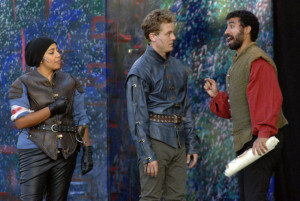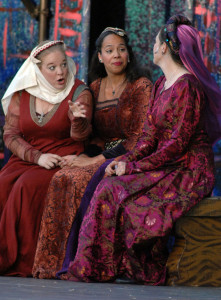Because It Is the Right Thing To Do: A Review of ROMEO AND JULIET at the San Francisco Shakespeare Festival
August 11, 2015 § 1 Comment
The Artistic Director of the San Francisco Shakespeare Festival, Rebecca J. Ennals, is leading the charge to broaden onstage opportunity in the Bay Area. Her democratizing impulses are prominently on display in her production of Romeo and Juliet, now touring area parks. In addition to featuring actors of color in close to half of the named roles, the production also achieves gender parity by casting actresses in a number of roles that are gendered male. More subtly, the cast also blurs the usually sharp distinction between “character” actors and “leading” actors by utilizing a wide variety of body and voice types in unexpected places.
Improving access onstage is a logical extension of the Festival’s mission of offering free Shakespeare in the park (along the Joe Papp model) to a broad spectrum of community audiences. The performances are enormously popular, playing to large crowds at all four of the Bay Area parks in which performances are held over the course of the summer.

Regina Morones, Carl Holvick and Mohammad Shehata as Benvolio, Romeo and Peter. Photo: Doug Jorgensen
The Concept Is that There Is No Concept
Interestingly, the much-improved diversity is not directly featured as an artistic statement about R&J at all. It is generally treated as invisible in this production. (Or should we say transparent?) That Romeo is a fairly conventionally cast white male who is convincing as a juvenile while Juliet is played by a powerful African-American “leading lady” (rather than an ingénue) is not foregrounded in any way. No West Side Story-style explanations for the feud here.
That Tybalt is played by the obviously female Carla Pantoja, albeit with a false beard to spell out the gender of the character, is just a matter to be taken in stride. She neither makes great effort to hide her underlying gender nor to use it to comment on the mindset of the man she is playing. Regina Morones’ Benvolio is more masculine in execution, but neither her ethnicity nor actual gender is disguised.
If any political point is made by these decisions, it seems to be that in an ideal world they should not matter so very much – and for the most part the production upholds this viewpoint. It is successful as a narrative in which we look through gender, ethnicity, and even the actors’ “types” to see the raw story. Often the surface appearances are contradicting or complicating what we see onstage, but the production offers no consistent viewpoint from that effect. The only convention employed is that we, as audience, are expected to look through the specific representations to a universal theme.
Similar Efforts
It is an interesting and admirable experiment. Similar efforts are going on in many Bay Area Shakespeare festivals this summer. California Shakespeare Festival (known locally as CalShakes) produced an almost all-female Twelfth Night earlier this season in which the actresses quite pointedly (sometimes with hilarious crudity) “commented” on their male personas. The Sacramento Shakespeare Festival produced an original practices (thus all-male) Romeo and Juliet, and then balanced it with an all-female As You Like It. Santa Cruz Shakespeare, meanwhile, is pursuing gender parity in its productions of Much Ado About Nothing and Macbeth, by changing the gender of characters along with all references to their gender in the texts.
In these contrasting examples, the diversity issues are carefully contextualized. Although I prefer this approach, Ennals’ choices are interesting precisely because she offers no internal explanations. The effect is sometimes distracting—I overheard quite a few confused murmurs from nearby audience members—but the crowd eventually accepted that the casting was both color- and gender-blind and stopped trying to read anything more into it.
Uneven Performances
The quality of the performance is uneven, but not because of anything having to do with the diversity choices. The scene painting is amateurish and Ashley Holvick’s costumes, although much better executed, are conventional. Ennals’ staging is frequently messy, and occasionally just odd. (The “morning after” scene, for example, is played on stage level, so the balcony-less Romeo is forced to jump down into the crowd in order to have any sort of descent.) The extensive doubling is successful, although at one point it becomes logistically complicated: Phil Lowery’s Friar Laurence having to be onstage in the final scene means that his Lord Montague cannot be. In the only significant rewriting, therefore, Lady Montague appears onstage in the final scene as peacemaker after the surprising news (to those that know the show well) that her husband has just died.
Romeo and Juliet are compellingly portrayed by Carl Holvick and Lauren Spencer, respectively. Their chemistry and energy are engaging. Spencer’s Juliet is more mature from the outset than any I have seen in years, but she is more effective in the last half of the show than most because she is not childish and she clearly understands the choices she is making. (It is actually kind of refreshing, for once, not to have to focus so hard on overcoming the inherent creepiness of men drooling over a thirteen-year-old.)
Gwen Loeb is wonderfully loud and bawdy as Juliet’s nurse, and in a doubling returns as the usually absent Lady Montague for the final scene, taking over all of her husband’s traditional lines. Phil Lowery’s Friar Laurence is earnest at every turn, and more sympathetic than usual. Mohammed Shehata is a powerful Prince Escalus, and is unrecognizable in his doubling as Peter, which speaks to his versatility. The rest of the cast is serviceable, without anyone standing out in either good or bad ways.
The show features two very surprising—and I think less than successful—choices of convention: in the first, whenever the play features a rhyming couplet with an historic rhyme (that is, one where the words once rhymed but because of pronunciation changes no longer do, such as love/prove or die/remedy) the original pronunciation of one or both is restored to regain the rhyme. That is actually fascinating, but certainly seems odd when numerous other original pronunciation issues—such as preservation of puns or scansion—are ignored.
The second is that after the epilogue, a traditional jig is performed by the full cast as the curtain call. It is not quite historically correct as original practice, as such jigs were separate entertainments (usually with risqué lyrics to songs in addition to the dancing) in Shakespeare’s time and not curtain calls. It was also not quite effective on its own terms since it broke the somber mode without transition or explanation. In these cases, the lack of contextualization (which worked for the casting) was problematic.
As of this writing, the show has finished its run in Pleasanton and Cupertino. It plays Saturdays and Sundays in Redwood City through August 23rd, moves to the Presidio in San Francisco through September 13th, and finishes its run at McLaren Park in SF, on September 27th.
Romeo and Juliet
San Francisco Shakespeare Festival
June 27 – Sept. 27, 2015
Various Locations throughout the Bay Area
Seen August 2, 2015

The all women concept is poewufrl for Shakespeare.It would be great to see the uncut R and J and perhaps Much Ado or Hamlet (cut version!) or Macbeth? What about having one or two older women with the younger to bring more age-related differences to bear?Thought the chemistry of the ensemble worked and their enthusiasm was energizing. Occasionally a couple of lines were a bit quiet and the balcony scene could be more dramatic. Wasn’t sure why Spanish nurse? But was a great theatre experience for us audience members and liok forward to your continuation!!